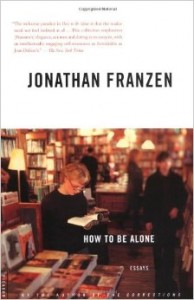 I first read How to Be Alone, a collection of essays by Jonathan Franzen, when I was 15—before I knew who William Gaddis was, or could define “postmodernism,” or understood the difference between realism and experimentalism. In other words: before I knew much about literature, or why it matters.
I first read How to Be Alone, a collection of essays by Jonathan Franzen, when I was 15—before I knew who William Gaddis was, or could define “postmodernism,” or understood the difference between realism and experimentalism. In other words: before I knew much about literature, or why it matters.
I knew a little. An English teacher at my high school in St. Louis, recognizing me as a slightly shy and sensitive young man, had pointed me to an essay he thought I’d like. It concerned a shy and sensitive young man’s high school years in St. Louis; its author was Jonathan Franzen.
Enthralled, I picked up How to Be Alone. Franzen’s literary arguments were lost on me, but his personal reflections were not. At the time, my grandfather was battling Alzheimer’s. My dad and I had just moved my grandparents from the house they’d lived in for 30 years, and I was coming to realize that I would not always be young. Reading Franzen’s essays about his father’s ordeal with Alzheimer’s, or about packing up his childhood bedroom, I felt the shock of recognition. I was coming to understand what words can do.
When I finally met Franzen at a book signing in St. Louis during my senior year, I handed him my copy of How to Be Alone and asked for advice about becoming a writer. In response, he wrote on the title page, “For Jim: For God’s Sake! Come to Your Senses!”
Eight years later, I still haven’t.

